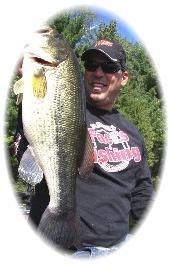|
St Lawrence Fishing
|
 BRONZEBACK
BONANZA Ė Fallís Monsters. BRONZEBACK
BONANZA Ė Fallís Monsters.
By
JP DeRose
People often ask me why I fish so late in the
season. The reasons are simple, NO BOATS, NO
SEADOOS, NO BACKED UP LAUNCHES, THE ENTIRE LAKE
TO MYSELF(basically)!!!!
For years I was a diehard deep weed line angler
for big fall largemouth bass. I would fish until
the end of November, searching for the greenest
weeds in the lake. Some days were unbelievable,
where you would catch 25 Ė 30, 3 pound plus
buckets, other days you would get 10 or 15. I
swore I had the greatest thing going, that is,
until I was invited to fish smallmouth bass in
November.
The term TOAD, GIANT or PIG when referring to a
smallmouth means that the fall is here. Never,
during anytime of the open bass season will you
see such brutes come up to play while fish
hitting the 7 pound mark are not unheard of and
6 pounders are seen almost on a daily basis yet
the best feature of fishing fall smallmouth bass
is the fact that they tend to school up. On a
lake like Erie you are allowed two
 rods
at a time and a quadruple header is not uncommon
and even better is the commotion in the boat
when this occurs, 2 guys, 4 fish on at the same
time Ė priceless!!! Itís not just Lake Erie that
produces. When things are right, Lake Simcoe,
and the southern parts of Georgian Bay, can
prove to be lethal with double headers and
non-stop action if you can stay on top of these
feeding fish. rods
at a time and a quadruple header is not uncommon
and even better is the commotion in the boat
when this occurs, 2 guys, 4 fish on at the same
time Ė priceless!!! Itís not just Lake Erie that
produces. When things are right, Lake Simcoe,
and the southern parts of Georgian Bay, can
prove to be lethal with double headers and
non-stop action if you can stay on top of these
feeding fish.
Lake Erie is a lake that you often hear about,
but many donít try it out. I was one of those,
always thinking that you needed a 20 foot boat
or a battleship to brave the Great Lake waters
and that couldnít be any further from the truth.
If you learn to pick your days, the spoils are
well worth the wait. An average day on any
smallmouth lake can produce 20 Ė 50 bass for a
pair of anglers, but when all goes right, you
will stop fishing because your arm wonít be able
to handle the abuse these feisty fish can dish
out.
TIMING
Starting in October, when the water
starts to hit in the 50ís, the smallmouth bass
begin the move to deeper water, looking to put
the feed bag on for the impending winter. In
lakes all over Ontario, there are phenomenal
smallmouth bass waiting to be caught, and a few
of the best lakes are Lake Erie, Georgian Bay,
and Lake Simcoe. These lakes offer very similar
structure and patterns, which can be utilized on
either body of water and if you already know
one, then you can apply the same knowledge to
the other.
FINDING THE FISH
The key to finding and catching big fall
smallmouth is a combination of mapping, and
graphing and without a doubt, the better the
sonar unit you have, the better your results
will be. When I fish a new area, the first thing
I do is look at a hydrographic chart of the lake
in question. Typical fall smallmouth locations
are rock, or rock/sand transitions in 20 Ė 50
feet of water and by analyzing the area I am
interested in I look for humps, gravel piles or
sharp drop offs which are adjacent to deep
water. Once these areas are found, you have to
find them on the water and the easiest way to
accomplish this is with any of the new
Humminbird Side Imaging GPS units, which use the
Navionics mapping chips. If you do not have this
feature, yet have a GPS unit or handheld,
computer programs such as Fugawi are available
for many of the lakes, and all you have to do is
put your cursor over the spot and it will give
you the latitude and longitude of those places,
and then input them into your unit. When fishing
large bodies of water, trying to locate off
shore humps can be a real problem, but with this
technology, itís as simple as can be.
Once you locate the spots, itís time to drive
over and around them, looking for two very
important features: 1. BAITFISH 2. HOOKS on your
graph and if you find either of these two
things, then itís time to fish. If you donít,
move to the next spot until you do.
BAIT SELECTION
Once you are on fish, your next
obstacle is to find out what they want. Come
fall time, I find that you really only need two
types of baits. There are many other ways to
catch them but these are two of the most
straight forward and most productive.
Without a doubt in my mind, my number one go to
bait is a tube. Dragging a tube will account for
70 percent of my deepwater smallmouth every year
however the colors and weight you throw can be
very critical. The key is to match the forage
that these big fish are feeding on and a
selection of 3Ē, 4Ē and even 5Ē tubes can be
very helpful. In most instances, they are
feeding on crayfish, perch or minnows depending
on the lake so if youíre marking suspended
baitfish, odds are they are feeding on smelt or
shiners and you should look to the smoke, white
or silver fleck tubes. When you are marking the
fish tight to bottom, smokes, greens and browns
are my go to colors and trust me when I say that
these are not the only ones that work, but they
are a starting point for everyday that I fish.
 Weight selection is dependant on the speed of
the drift. You want to have bottom contact with
the tube bumping it off the rocks and dragging
it through the sand to trigger strikes. I have
thrown as heavy as 5/8 ounce jigs in my tubes
when fishing in some rough stuff while using 2
drift socks to control the speed of the drift.
On a normal day 3/8 ounce jig will do the trick,
but the best advice I can give you is to have a
wide variety of jigs on board. In my box, I have
1/8, 3/16, 1/4, 5/16, 3/8, 7/16, 1/2, 5/8,
11/16, & 3/4 ounce jigs as this allows me to be
in the strike zone no matter the conditions. Weight selection is dependant on the speed of
the drift. You want to have bottom contact with
the tube bumping it off the rocks and dragging
it through the sand to trigger strikes. I have
thrown as heavy as 5/8 ounce jigs in my tubes
when fishing in some rough stuff while using 2
drift socks to control the speed of the drift.
On a normal day 3/8 ounce jig will do the trick,
but the best advice I can give you is to have a
wide variety of jigs on board. In my box, I have
1/8, 3/16, 1/4, 5/16, 3/8, 7/16, 1/2, 5/8,
11/16, & 3/4 ounce jigs as this allows me to be
in the strike zone no matter the conditions.
The second bait, and probably my favorite is a
jigging spoon. Jigging spoons have always
produced some of my biggest fall smallmouth bass
and there are a lot of jigging spoons on the
market and all have their day, but a couple of
the more consistent producers for me are the
Crippled Herring and the BPS XPS Tungsten
Jigging Spoon. Just like the tube jig heads, it
is equally important to have a good variety of
weights on hand to be able to keep these spoons
as vertical as possible. I like to have 1/2 oz,
3/4 oz, 1 oz, & 1 Ĺ oz jigs on hand. The most
common size for me is the 3/4 ounce, because I
like the way it falls and the feel of the spoon
when jigging however this is just a personal
preference. One thing that should be mentioned
is that if one of your fish happens to spit up
some food, as they often do, check the size and
what it is as this can pay huge dividends when
choosing you spoon size or tube color, and size.
The colors of the jigging spoons are quite
simple, Silver, Gold, whites, and Chartreuse or
any combos of these are all good choices.
The jigging action used can be a variety of
cadences just like jerk bait fishing, every day
is different, just let the fish tell you what
they want. I typically start with a standard
snap sweep and change up until I get hit and
keep in mind that generally the bait is right
near bottom and swept 4 feet in the upwards
direction and 90 percent of the hits will be on
the spoonís flutter down, so donít be surprised
on the next sweep if your rod is stopped in its
tracks. This is why I love the bait, you never
know when, but when they hit and you set into a
moose, your heart just stops!!! A big fish can
be compared to wrestling a Volkswagen off
bottom, they donít want to come up, and they
will prove it.
RODS, REELS & LINE
When it comes to choosing the appropriate rod
for the task at hand, I have always leaned
towards a 6í8Ē - 7'2" medium heavy rod with a
fast tip. Spinning rods that are rated 6-15 or
8-17 lb test usually fit this description. As
for my jigging rods, a 6í6Ē or 7í medium with a
fast tip is used. Bait casting rods that are
rated from 8-14 or 10-17 lb test are good
choices. The reels are open to anyoneís
preference as it has to feel good in your hand.
All I can recommend is a good drag with some
decent line capacity. Usually the 2500 series or
3000 series of reels are good choices for size
but the real debate over line will continue for
years to come...Braid or Mono? Personally I like
the braid in the deep for dragging tubes;
however I prefer mono for jigging spoons.
For the tubes, 15 Ė 20 lb braided line really
does the trick and when they are a little picky,
try running a mono or fluorocarbon leader. Try
to go as heavy as the fish will allow, as you
will almost always be dragging through rocks and
of course zebra mussels but generally 10-14 lb
test will do the trick.
As for my jigging rods, 14-17 lb Fluorocarbon is
all I have ever used and probably ever will. It
has served me well over the past couple of
years. Many anglers choose braid for the
sensitivity and it can be very useful in
detecting the bite on the drop.
My last piece of advice is to dress properly;
layers of clothes, survival suits and hats are
highly recommended as are a good pair of
insulted boots and gloves. Itís better to have
on too much than not enough. Put a lighter
jacket in the boat incase things heat up in the
afternoon and remember if you find them, they
will come (to eat), just donít let go of your
rod because your arm is hurting!!!!
 
Tight lines and long weekends
JP DeRose
|